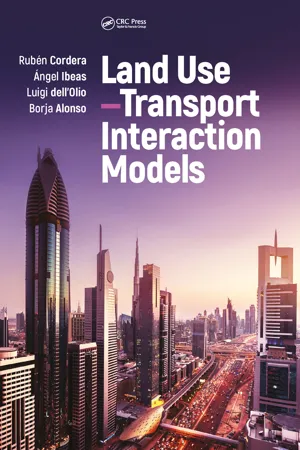![]()
Section II
The Theoretical Basis of Land Use–Transport Interaction Models
This section provides a review of the theoretical basis behind the land use–transport interaction (LUTI) model simulation. Chapter 3 concentrates on accessibility as the primary link between the transport system and the land use system. Chapter 4 provides a brief review of the microeconomic theory underpinning the theoretical relationship between transport and land use, whereas Chapters 5, 6, 7 address three paradigms that have been widely applied in the field of operational LUTI models: (1) spatial interaction theory, (2) random utility theory and (3) the optimisation approach.
![]()
3 | The Nexus between Transport and Land Use: Accessibility |
| Hugo González, Rubén Cordera and Ángel Ibeas |
CONTENTS
3.1 The Relevance of Accessibility
3.2 Factors That Influence Accessibility
3.3 Types of Indicators Available for Measuring Accessibility
3.3.1 Accessibility Indicators Based on the Transport System
3.3.2 Accessibility Indicators Based on Accumulated Opportunities
3.3.3 Accessibility Indicators Based on the Gravity Analogy
3.3.4 Accessibility Indicators Based on Individual Utility
3.4 Conclusion
References
3.1 THE RELEVANCE OF ACCESSIBILITY
Making a journey between two zones on a transport network depends on the following three fundamental elements (El-Geneidy and Levinson 2006):
1. The potential of the origin zone to generate the journey. This variable will further depend on the number of inhabitants in the zone, the population’s level of motorisation and their standard of living along with other factors.
2. The capacity of the destination zone to attract a trip. The attraction depends on the population, the number of commercial premises, the number of jobs and other facilities present in the destination zone.
3. The difficulty in travelling between the origin and destination zones. In order for this to affect the journey, the effect of this cost has to be lower than the destination’s power of attraction.
Depending on the scale of the study, the zones considered to be the producers and attractors of trips may correspond to more or less large areas within a city or even entire population nuclei if the research is regional.
Better standards of infrastructure and transport services will modify the journey cost and enable communication between zones, in other words, improve a component of accessibility. The cost of a journey is a basic variable as shorter journey times and less money required for travelling means that more places become reachable within a determined budget, thereby increasing accessibility.
The destinations and the available activities they offer are also important: the greater the number of possible destinations, the greater the variety of available opportunities which, again, will improve accessibility. The modal choice for making the journey is equally crucial: a wider range of the possible transport modes for reaching the destination means greater choice for the user, resulting in an increased accessibility.
The concept of accessibility has formed a part of transport and land use planning for more than 50 years. One of the first attempts at applying it in the planning field was made by Hansen (1959), who defined accessibility as a measure of the intensity of the possibility of an interaction. Other similar definitions also differentiate two components of accessibility: (1) an element of transport (hindrance or cost) and (2) an activity that motivates or attracts the journey (opportunity or profit) (Burns 1980, Koenig 1980). More recently, authors like Batty (2009) distinguished between the relative accessibility of one place to another from the calculated accessibility from one place to all the other places. In the latter case, the resulting accessibility index provides a synthetic measurement of the ability of reaching a certain type of opportunity from a place of origin.
Thus, accessibility may be defined as a measurement of the capacity to communicate between human activities or settlements using a determined transport system. The usual measurement units are distance, time, journey cost and the number of opportunities or adimensional variables resulting from their interrelationships. By calculating the accessibility levels that are provided by a transport network, the planner or decision-maker has a tool that allows them to
• Identify the places with least accessibility and therefore fewer possibilities of mobility and access to opportunitie...
